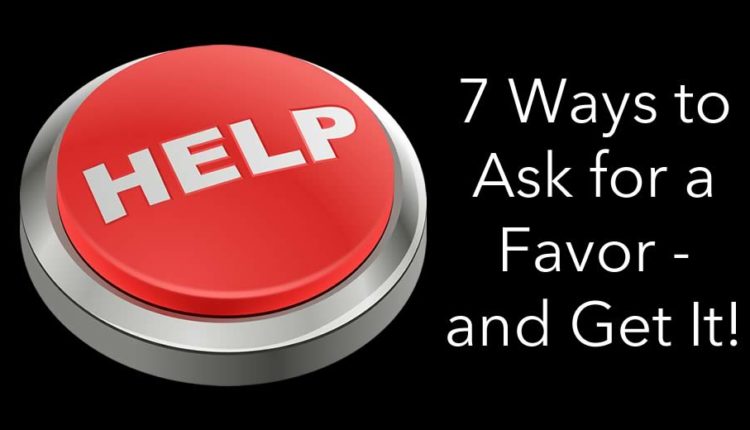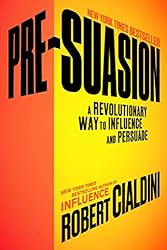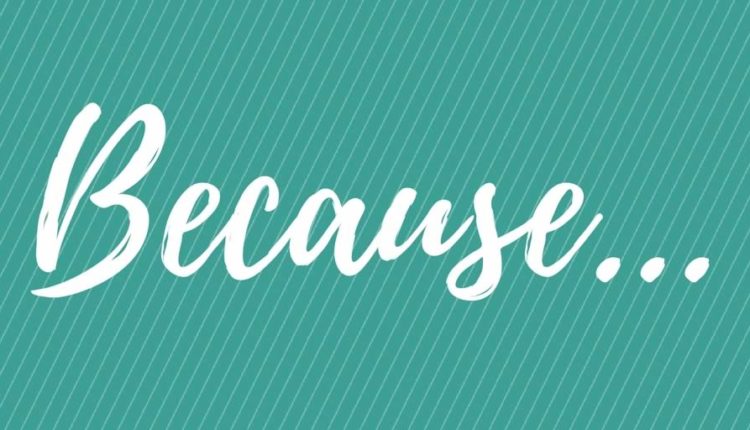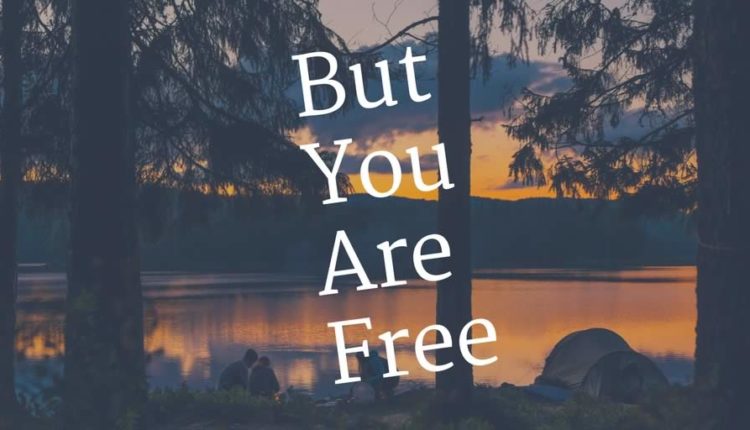7 Ways to Ask for a Favor – and Get It!

Almost every day, I get emails from people I barely know (or don’t know at all!) asking for favors. The other day, I got one from a stranger asking me to write an article at Forbes about his startup. What persuasive language did he use? The sole reason he offered was, “We’re looking to announce our seed round and/or spread the word about what we’re doing.” Who wouldn’t be persuaded by that?
To my surprise, the email didn’t even say what this startup was doing. A ride-sharing app for jets? IoT-enabled underwear? I would have had to open an attachment to find out. Who opens attachments from strangers? I deleted the email and forgot about it.
Two days later, the same guy sent me a second email that said only, “Just making sure you saw this.”
The good news for this sender is that his email DID inspire me to write an article. The bad news is that I’m not going to promote his company in it. (Sorry.)
The most practical and obvious thing that would have improved this failed pitch is a short paragraph explaining why readers would be interested in the startup. Every journalist, blogger, and content creator wants good stories. For this company, I presume there was a unique and compelling story that brought investors in. What excited them enough that they forked over their hard cash? That might be a story. The follow-up email could have taken a totally different angle to increase the odds of hooking the reader.
But, that’s just practical, logical advice.
If you want to avoid the same fate when YOU ask for a favor, there’s plenty of psychology research to guide you. Here are seven of my favorite ways to maximize your chances of a favorable outcome:
Invoke Reciprocation
One of Robert Cialdini’s seven principles of influence is “reciprocation.” His research and that of other scientists shows that if you do someone a favor first, they are more likely to reciprocate. The favors need not be equal in magnitude. Hold the door for someone, and they will be more willing to spend a few minutes giving you directions.
Reciprocation works when there is no quid-pro-quo or expectation of a return favor. If you suggest a trade, like promising a free ebook in return for giving up a visitor’s email, you probably will convert more visitors. But, that’s not reciprocation. It’s an exchange of value.
Need a favor? Do the other person a small favor first! #Neuromarketing Share on X
So, before you make your request, do something for your target first. Trying to get a favor from a thought leader or influencer? Share her content on social media. Write a review of his latest book. Refer a potential client or speaking opportunity.

The timing of this favor is important. In Cialdini’s newest book Pre-Suasion, he points out that the moment immediately after a favor is granted is the most effective time to ask for one. But, another approach would be to allow a bit of a time gap so there seems to be less linkage between the favors. Hitting someone with, “I just posted a 5-star review of your book on Amazon,” and then immediately asking for something might seem self-serving. Still, it probably has a better chance of success than just asking for the favor.
But, there’s a caution. One study showed that high status individuals felt that lower status individuals who did them favors were insincere and trying to curry favor. (PDF)
Invoke Liking
 Another Cialdini principle is “liking.” When you highlight things you have in common with your persuasion target, your request is more likely to be granted. Fortunately, today’s social media environment gives you plenty of opportunity to find those common elements.
Another Cialdini principle is “liking.” When you highlight things you have in common with your persuasion target, your request is more likely to be granted. Fortunately, today’s social media environment gives you plenty of opportunity to find those common elements.
A little stalking on LinkedIn, Facebook, Twitter, and Instagram will almost surely turn up something. Perhaps you attended the same school, or lived in the same city. Maybe you are both dog owners. Or photography buffs. Pointing out your commonalities before bringing up the favor you need will boost your chances of getting it.
Use Flattery

Flattering someone makes you more likable and makes your message more memorable. Remarkably, research shows this happens even when the flattery is seen as likely to be insincere. When the sommelier compliments you on your good taste and extensive knowledge while trying to sell you the most expensive wine on the menu, you probably suspect his motives. But, the ploy may still get you to choose a more expensive bottle.
The flattery approach has become commonplace. I get daily email pitches that start with how much the writer enjoys my work. Some may even reference a specific article. Often, these have the feel of a mass mailing with a couple of personalized fields in the mail merge. Very few of these emails show any evidence that the writer has actually read my content. Often, the writer’s credibility is further damaged by the pitch being wildly off-target.
To stand out from the canned pitches, use flattery wisely. Pay the recipients a compliment that shows you are really familiar with them and their work. Whatever you do, don’t sound like a mail merge gone awry.
Flattery increases your persuasive ability. BTW, you look great today! #Neuromarketing Share on X
And saving the flattery for the end may work better than leading with it, according to author Simon Sinek. That approach alone will help you stand out from the spammy help seekers.
Ask in Person

While it may not always be possible to ask for a favor in person, do it if you can. A 2016 study showed higher in-person success rates than those from email. Three highlights of the study:
1. People underestimate compliance when making requests of strangers in person.
2. Requesters overestimated compliance when making requests over email.
3. Requesters failed to appreciate how untrustworthy their emails would seem to others.
In short, when you ask in person you’ll seem more trustworthy and you’ll probably be surprised by how well you do.
Ask for a Small Favor First
 If you need a fairly big favor from someone (say, reading the draft of your book or screenplay), ask them for a small favor first (for example, answering a simple question or liking a post). This seems counterintuitive. Wouldn’t asking for two favors be even more annoying than just one?
If you need a fairly big favor from someone (say, reading the draft of your book or screenplay), ask them for a small favor first (for example, answering a simple question or liking a post). This seems counterintuitive. Wouldn’t asking for two favors be even more annoying than just one?
In fact, another Cialdini principle, “commitment and consistency,” comes into play. Because they did the small favor for you, it would be inconsistent to refuse the bigger favor. The inconsistency would create cognitive dissonance, and our brains don’t like that condition. The mental tension can be resolved by granting both favors.
This effect has been known for centuries. It’s called the Ben Franklin Effect because of Franklin’s maxim,
“He that has once done you a kindness will be more ready to do you another, than he whom you yourself have obliged.”
Franklin employed the strategy himself by asking to borrow a rare book from a political rival. After the request was granted, their relations thawed and they became lasting friends.
Give a Reason. Any Reason.
Studies have shown that even irrelevant reasons can increase compliance. The word “because” seems to have an almost magical effect.

The classic Cialdini experiment used a copy machine queue to test this effect. The experimenter would attempt to cut in line while people were waiting to use the machine. When the experimenter offered the nonsense reason, “because I need to make copies,” compliance jumped to 93% – essentially the same as when a logical reason was offered. With no “because” at all, compliance was just 59%.
The power of 'because' - even nonsense helps you be persuasive! #Neuromarketing Share on X
The email I described at the start might have been marginally more effective had it used a phrase like, “…because we need to get the word out about…” It’s not logically persuasive, but it does offer a “because.”
Give Them an Out
Here’s another counter-intuitive finding: letting people know they have a choice makes them more likely to be persuaded, not less. Many sales pitches and other requests close by explaining why the target has to act. That approach doesn’t work. The tactic of offering people a choice has been tested in so many labs around the world that it has an acronym: BYAF. That stands for “but you are free to choose.”

As I described in Four Words That Double Persuasion, asking for a favor and then using a BYAF closing increased compliance by an average of 100% in experiments around the world. Researchers think that offering the option to choose removes the feeling of being pressured to grant the favor. This makes people more likely to agree.
You probably shouldn’t use those exact words, but letting the recipient know that there’s no pressure will increase the probability that you’ll get what you are looking for.
Set Up a Future Favor
Sometimes, you’ll do a favor for someone from whom you don’t need immediate help. At least, if you are a good person you will do that. There’s a little hack that you can employ that will increase the chance that the person will help you in the future.

My friend Guy Kawasaki got this tip from Robert Cialdini… When someone thanks you, instead of replying with the usual, “You’re welcome,” or, “It was nothing,” try this:
“I know you’d do the same for me!”
That amplifies reciprocation. It’s the favor that you did first that invokes the effect, but the phrase is a reminder that creates a tacit commitment from the other person. But, as I’ve noted before, do this in a friendly, casual way that doesn’t sound like you expect a debt to be repaid.
Don’t try to build all these techniques into a single request. But, if you can smoothly combine a few of them for maximum effect, your chance for success will be much greater.
And, if you are using a personalized approach, do it right. Don’t make bland statements that could apply to anybody. Rather, use it in a way that tells recipients that you are truly interested in them and their work.
7 ways to ask for a favor - and get it! #Neuromarketing Share on X
